JQ Magazine: Book Review – ‘Tomo: Friendship through Fiction: An Anthology of Japan Teen Stories’
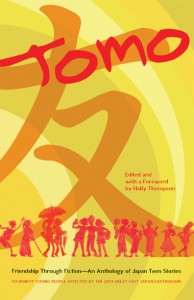
“Reading ‘Tomo’ is a reminder that even in the most desperate straits, friendship and personal relationships have the power to nourish and sustain us.” (Stone Bridge Press)
By Sharona Moskowitz (Fukuoka-ken, 2000-01) for JQ magazine. Sharona is interested in fresh, new voices in fiction and creative nonfiction.
If you could know your future cause of death, would you choose to know? This is the question posed by “Yamada-san’s Toaster,” one of the short stories in the new fiction anthology Tomo: Friendship through Fiction: An Anthology of Japan Teen Stories. As the title suggests, the collection is geared toward adolescents and dedicated to the youth of Tohoku, though it undoubtedly has— in the parlance of publishing— tremendous crossover appeal. There is plenty for adults to enjoy here, too. Edited and with a foreword by Holly Thompson, this collection features 36 stories—including 10 in translation—contributed by several JET alums from around the world, all of whom share a connection to Japan. Proceeds from its sale will go directly to the continued relief efforts.
In Kelly Luce (Kawasaki/Tokushima, 2002-04)’s story, Yamada-san’s toaster burns into each slice of bread a Chinese character supposedly predicting one’s cause of death. The tale’s young narrator observes the effects of the toaster on the townspeople as news spreads and they become stirred into a ridiculous pandemonium. There’s a great element of humor to the story though it also reveals a universal human folly: the vulnerability towards superstition. People try desperately to find order and make sense of a chaotic and random world, even if it means looking for burnt kanji of the toast on a breakfast plate.
The stories are grouped thematically, represented by “Shocks and Tremors,” Friends and Enemies,” “Ghosts and Spirits,” Powers and Feats,” Talents and Curses,” Insiders and Outsiders” and “Families and Connections.” (The final story, the poignant “Peace on Earth,” is penned by Suzanne Kamata (Tokushima-ken, 1988-90), whose own book of short stories, The Beautiful One Has Come, was released last year.
Huffington Post article by Rikuzentakata JET alum Sarah Ruddy
![]() Former Rikuzentakata JET Sarah Ruddy, a web producer for New York Magazine, was recently by Huffington Post to write an article in connection with the one-year anniversary of the 3/11 Tohoku earthquake and tsunami. (On a side note, I noticed that Sarah mentions another JET alum in the article, author/humor writer Will Ferguson who wrote Hitching Rides With Buddha among other books.)
Former Rikuzentakata JET Sarah Ruddy, a web producer for New York Magazine, was recently by Huffington Post to write an article in connection with the one-year anniversary of the 3/11 Tohoku earthquake and tsunami. (On a side note, I noticed that Sarah mentions another JET alum in the article, author/humor writer Will Ferguson who wrote Hitching Rides With Buddha among other books.)
Here’s the article:
After The Tohoku Earthquake: ‘I Gave Up My Family For Dead’
http://www.huffingtonpost.com/sarah-ruddy/after-the-tohoku-earthqua_b_1335092.html#s770689
Here’s an excerpt:
My decision to go back was not about whether I should but how soon I could. I was determined to do whatever I could to help. I was often asked if I was afraid of another earthquake and tsunami occurring or how the radiation would effect me. There are plenty of dangers in the world that we can’t predict or prevent. They shouldn’t stop us from experiencing life.
I ended up going last November, seven months after the tsunami hit. I was welcomed by friends and generously offered a place to stay. I heard their stories of that day and the seven months that followed. The improvements made in that time were incredible.
I volunteered in Rikuzentakata and Ofunato, the city immediately north, and returned to my former schools to help out with classes. The people I volunteered with were from all over Japan, including students who were on break, retired couples who had free time and curious people who wondered how anyone could have survived. I spent long hours digging through fields of sediment and debris.
Justin’s Japan: Interview with Jin Akanishi on ‘Japonicana’ and His American Tour

"The word ‘Japonicana’ comes from Japan, America and Spain. The ‘a’ sound is for the females, so my album is a girl. There’s more than one genre—dance, pop, hip-hop, and R&B. It’s like my baby, because I created it from scratch." (Courtesy of PLAN C Agency)
By JQ magazine editor Justin Tedaldi (CIR Kobe-shi, 2001-02). Visit his Examiner.com page here for related stories.
In his native Japan, Jin Akanishi is a superstar. Since his early teens, he’s achieved fame as a pop idol, singer-songwriter (with the groups KAT-TUN and LANDS), actor, and radio host. After launching a successful American tour in 2010 to sold out (and screaming) crowds, Jin is back in the U.S. supporting his hotly anticipated English-language debut album, Japonicana. Released earlier this month, the disc features production by Grammy Award-nominated trio the Stereotypes (Far East Movement, Ne-Yo) and platinum hit maker Static Revenger (Madonna, Shakira).
Jin takes Manhattan at New York’s Best Buy Theater tonight (March 15) and hits San Francisco’s Regency Ballroom on March 17. In this exclusive interview, I spoke with the 27-year-old about the tour, the making of the album, his love for hip-hop, and hanging out with Justin Bieber.
How would you describe the new album?
The word “Japonicana” comes from Japan, America and Spain. The “a” sound is for the females, so my album is a girl. There’s more than one genre—dance, pop, hip-hop, and R&B. It’s like my baby, because I created it from scratch.
How has the tour been going?
It’s really great. The crowds are great, good energy, dancers, and a lot of drinks (laughs).
What can fans expect at the shows this time? What’s different?
It’s a totally different concert. Everything’s different.
Is there a highlight you can tell us about?
Crazy lights and dancing. All the songs are from Japonicana.
You mentioned that the title represents all the places that influence you—Japan, America and Spain. How have they influenced you?
I’m Japanese, obviously. And America, my mom loves American music and used to listen to it when I was little. I kind of grew up with it. My best friend’s mom is Spanish, and she taught me a lot about the culture. So that’s how I got influenced.
For the complete story, click here.
JET alum journalist Graham Shelby’s latest article on Fukushima 03.11.12
Graham Shelby (Fukushima-ken, Ishikawa-shi, 1994-97) has published a thoughtful piece on Fukushima, this one on Kentucky news site, Kentucky.com, in addition to previous radio and written pieces he has done for NPR and other news outlets.
“Quake, tsunami a year ago refreshed Kentuckian’s memories of time in Japan”
By Graham Shelby – contributing write
Posted: 12:00 AM on March 11, 2012
Twenty-three years old and eager to get out of my hometown, I left Lexington for Japan. In the summer of 1994, I took a job teaching English in Ishikawa, a small town surrounded by rice fields and forested hills in Fukushima Prefecture, about 100 miles north of Tokyo.
Click here to read the full article: http://www.kentucky.com/2012/03/11/2104978/quake-tsunami-a-year-ago-refreshed.html#storylink=misearch
Justin’s Japan: New York Marches Into Spring with Gagaku, Kabuki Masters
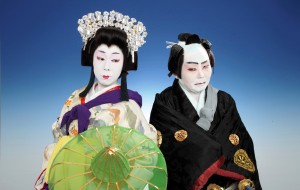
Nishizaki Emino, left, and Bando Kotoji, right, perform at Japan Society's Kabuki Dance March 29-31. (Toshio Kiyofuji)
By JQ magazine editor Justin Tedaldi (CIR Kobe-shi, 2001-02). Visit his Japanese culture page on Examiner.com here for related stories.
As winter gives way to spring, New York will host special performances of the traditional Japanese performing arts of gagaku and kabuki for a modern audience.
At Highline Ballroom on March 28 is Hideki Togi with Iwao Furusawa. Known as the flame keeper of gagaku (ancient Japanese court music), Togi embodies a proud 1,400-year legacy. Furusawa is a multi-award-winning violinist who has collaborated with Togi for over 15 years, drawing 20,000 people every year in their joint annual national tour. The music drawn from different streams of tradition—Togi from the East and Furusawa from the West—transcends the boundaries of music and art.
As part of its Sakura — Spring Renews, Beauty Blooms festivities (which mark the 100th anniversary of the gift of cherry trees from the Land of the Rising Sun to New York and Washington), Japan Society will host three nights of Kabuki Dance from March 29-31. Led by master dancer Bando Kotoji and a dozen other performers to the accompaniment of live music, visitors will be treated to the elegant and refined art form of nihon buyo, centuries-old Japanese dance.
Using traditional kabuki dance techniques while incorporating the individual expression associated with Western “high-art,” nihon buyo performers have built a repertoire that now consists of popular sections from famous kabuki plays as well as pieces inspired by classical noh plays and old folk tales. They have also integrated musical elements from kabuki and bunraku such as shamisen and storytelling chanters.
JQ Magazine: On Japanese Winters and Well Endowed Snowmen
By Preston Hatfield (Yamanashi-ken, 2009-10) for JQ magazine. Preston moved from San Francisco to New York City in January 2012 and is now accepting submissions from people who want to be his friend. Abduct him from his house in the middle of the night, or find him on Facebook and ask about his JET blog in which he details his exploits and misadventures in that crazy Land of the Rising Sun we all love.
On JET it may be true that everyone’s situation is different, but I’d bet my left dango that each of us, for whatever extenuating circumstance, suffered a few restless nights without heat in our rooms. My bone-chilling tale of refrigery and woe took place when 2010 was newly born, in the sweeping valleys of Yamanashi Prefecture. I lived in Kofu’s International Exchange Center, a westernized building converted from an old motel with all the comforts of home: shower, central heating, high speed Internet, furnished everything—which is to say I’d gotten used to a very comfortable lifestyle. I was overdue for a slice of humble sashimi.
I should mention that Kofu is not a cold place. It usually gets one storm where the snow sticks, and even that only lasts a few days. But that means nothing to a California boy. The moment my room dropped below its usual 72 degrees of moderation I knew I was in for it and got my building supervisor on the phone. He showed up a few minutes later, a shrunken old man who’d apparently won the battle against time, for indeed time had already done its worst and still the man was up and (very gradually) at ’em.
“A couple of days,” he told me after examining the fuses. “You’ll have to hang in there until then.” I looked out my window where the sky was semi-busy dropping the one good bit of snowfall we’d have that year. By now I imagined the temperature inside had dipped into the upper 60s and the first stages of hypothermia couldn’t be far off. Neither could the epic hissy fit I was about to throw.
Embassy of Japan in the UK Webmagazine (March 2012)
Embassy of Japan in the UK Webmagazine round-up. Posted by JET alum and current editor of the webmagazine, Dipika Soni (Ishikawa-ken, 2003-06). To subscribe to the Embassy of Japan’s monthly webmagazine, email webmagazine@ld.mofa.go.jp with the subject ‘subscribe’.
——————————————————————————————————————————–

Embassy of Japan in the UK Webmagazine: March 2012
Ambassador’s blog
One year on
Featured article
ONE YEAR ON: SCENES OF RECONSTRUCTION & PICTURES DRAWN BY THE CHILDREN OF TOHOKU
Other articles:
Events around the country as the UK remembers “One year on…”
The Tsunami and the Cherry Blossom
One year on: A JET perspective
Films at the Embassy: Bloom in the Moonlight
Films at the Embassy: Tohoku Special Film Show
JAPAN-UK Events Calendar
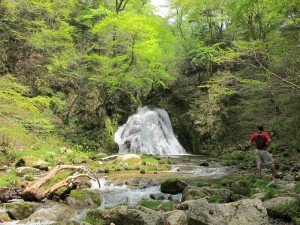
At scenic Setogaro Gorge in Iwaki, fifth year JET Peter Gillam says people are not seeing Fukushima for everything it is. “What people need to know most about Fukushima is that it is a prefecture first, a city second, and a nuclear reactor a distant third,” he says. “Not the other way around.”
Who’s telling the truth about radiation in Japan, and why it might not matter anyway.
By James A. Foley (Fukushima-ken, 2007-10) for JQ magazine. James was one of eight American JET alums selected for the Tohoku Invitational Program sponsored by the Ministry of Foreign Affairs and the Japan Tourism Agency.
Nastassja Vidro knew something was awfully wrong when the March air turned yellow.
It happened while she was outside on the playground with the eight students she taught English to at Shiramizu Elementary in Iwaki City, Japan, after the earth began to move.
Vidro, a 2007-2011 JET participant, was by then an old pro at earthquakes. She had lived in seismically active Japan nearly four years, and in California for more than two decades before that. But this quake was different. The earth rocked so violently that huge clouds of pollen erupted from the trees and hung in the air, casting the scene in an eerie hue.
The school principal ran outside, telling everyone to get in the center of the schoolyard and huddle together. Crouched on the ground with her students, Vidro kept waiting for the tremor to subside, but it went on. For six minutes.
She heard a fantastic noise—“like a monster roaring, not screeching, but deep, [and] I could hear the wood creak and bend and the earth move”—and ceramic shingles rattling off neighboring houses and shattering on the pavement.
She says she felt the ground quiver beneath her. She fixated on it, amazed.
“My hands were on the ground and the movement was pushing them off,” she says. “I’m not a very religious person, but I was praying so hard. I hoped the earth didn’t crack.”
She looked toward a fellow teacher, a Japan native, whose eyes were wide.
“I could see in her face that this was bad, that it was not an average earthquake,” she says.
JQ Magazine Seeks Writers for Spring 2012!
As we march into spring, JETAA New York’s JQ magazine continues to provide content with an ever-expanding array of articles, interviews and features (see our recent stories here). We’re now looking for new writers, including recent returnees and JET vets, from all JETAA chapters worldwide for posting stories via our host at the global JET alumni resource site JETwit.com. (Scribes are also encouraged to join the JET Alumni Writers group on LinkedIn.)
Below are story ideas grouped by JET participants and alumni (JET World) and those more on Japanese culture (Japan World). If you’re a JET or JETWit contributor from anywhere in the world, we welcome your interest or additional story ideas! Contact JQ’s editor Justin Tedaldi (magazine [at] jetaany [dot] org) to sign up for stories, and click here to see the story ideas online.
Click “Read More” below for our spring 2012 ideas pitch package.
Justin’s Japan: March Movies at Japan Society, New York International Children’s Film Festival

Makoto Shinkai’s ‘Children Who Chase Lost Voices from Deep Below’ is a modern-day Orpheus tale with a sci-fi twist that pays tribute to the great works of Hayao Miyazaki. (Courtesy of GKids)
By JQ magazine editor Justin Tedaldi (CIR Kobe-shi, 2001-02). Visit his Japanese culture page on Examiner.com here for related stories.
Oscar season may be over, but this month offers a score of cinematic delights from Japan Society and the New York International Children’s Film Festival.
As part of its Love Will Tear Us Apart Globus Film Series, Japan Society presents outré love stories from Japan and Korea, including the U.S. premiere of Shinya Tsukamoto’s KOTOKO (March 2) and the world premiere of Koji Wakamatsu’s Petrel Hotel Blue (March 7) among 23 seminal films from the genre.
Other highlights include Hirokazu Kore’eda’s Air Doll (March 3), Nagisa Oshima’s arch-classic In the Realm of the Senses (March 16), Yukio Ninagawa’s Snakes and Earrings (March 16), Lee Sang-il’s Villain, (March 9) Lee Chang-dong’s Oasis, (March 18) and Kim Ki-duk’s Bad Guy, (March 10), among other twisted tales of star-crossed lovers on the rocks and on the run. (Click here for a complete list of films and showtimes).
For younger cineastes, the critically acclaimed New York International Children’s Film Festival kicks off its 15th anniversary event from March 2-25 at New York’s DGA Theater, Walter Reade Theater, IFC Center, Peter Norton Symphony Space, Asia Society, Scholastic Theater, and Cantor Film Center.
The nation’s largest festival for kids and teens will present four weeks of ground-breaking and thought-provoking new works for ages 3-18, with 100 new films, opening and closing galas, new feature premieres, six short film programs, filmmaker Q&As, filmmaking workshops, and the NYICFF Awards Ceremony. This year’s edition features three Japanese films from 2011.
For the complete story, click here.
Job: Translator for Fukushima Panel Event (NYC)
By JQ magazine editor Justin Tedaldi (CIR Kobe-shi, 2001-02). Visit his Japanese culture page on Examiner.com here for related stories.
The producers of this year’s New York Peace Film Festival are seeking a translator for Sunday, March 4 and Monday, March 5 to assist with events leading up to the actual festival the following week at the Unitarian Church of All Souls.
The producers are now coordinating with local activists and guests from Japan for an entire week of events relating to Fukushima. There will be an energy expert, professors, and a worker from the crippled Fukushima Daiichi and Daini nuclear plant, who will speak to the public on March 5 at Riverside Church, and for emergency workers and first responders including doctors and others at Manhattanville College on March 6.
Due to the nature of panelists and audience on March 6, an able translator and interpreter is needed. This will be paid work. For more information, please e-mail NYPFF executive producer Yumi Tanaka at yumicomic [at] gmail [dot] com.
To read an interview with Yumi on last year’s New York Peace Film Festival, click here.
By Wendy Ikemoto (Ehime-ken, 2006-2011). Wendy taught at six crazy but lovable high schools and served as a Prefectural Advisor on JET. Now based in the equally crazy New York City, she is looking for her next challenging career opportunity. Wendy is a fan of reading, writing, and cooking as a form of socialization. Visit her LinkedIn profile here.
I learned the hard way that bicycles and snow don’t mix.
It wasn’t that I didn’t have my suspicions about this, but I: a) Needed to get to the train station, and b) was inexperienced with the fluffy stuff (it was only the second time in years that snow in my country town hadn’t immediately melted away, and as a Hawaii girl, the snow seemed more novelty than threat).
So on a January morning in Ehime, I left my apartment to catch a train into town. I followed the same route to the station that I used hundreds of times. I rode past a small temple on the hill. I enjoyed watching the animals in the river along the road. I took the turn by the bridge and in slow motion, my tire slipped out from under me and I crashed. SMACK–I fell on the back of my head.
I couldn’t move for a moment.
Before I could regain composure, I started to get dragged off. A kind Japanese couple had seen the whole thing and sensibly moved me out of the road. I was very grateful, but hugely mortified. After about a minute, I thanked them profusely, assuring them that I was OK, and managed to get back on my bicycle. Slowly and wobbly, I made it to the station.
I met my friend, we bought our train tickets, and through the gate we went to wait for our train. This was my first moment to relax since the accident. Although I felt fine, I decided to inspect the back on my head. Lightly, my fingers caressed where I crashed until they came upon a bump. Not the hard kind that happens when you knock your head against a shelf, but the soft kind that happens when you have a blister. Crap. Well, maybe I can go to the doctor tomorrow, I thought.
When I brought my hand down into my lap, however, I noticed that it looked funny…there was blood all over it.
Justin’s Japan: Interview with DJ Krush on His 20th Anniversary Tour

"Everyone’s using computers these days, but when I was young analog was king. Today everyone’s using the same software, so it can sound a bit dull. On the other hand, there’s plenty of surprising music you can create, so that’s what I’m aiming to do." (Justin Tedaldi)
By JQ magazine editor Justin Tedaldi (CIR Kobe-shi, 2001-02) for Examiner.com. Visit his Japanese culture page here for related stories.
Born Hideaki Ishi in Tokyo, DJ Krush is one of the world’s most acclaimed electronic music artists and producers. He first made his name in hip-hop in the 1980s as the founder of Krush Posse, and his style now transcends category much like his idol Miles Davis, who dropped the “jazz” label for “music” in the late 1960s.
Continuing his world tour, DJ Krush plays at The MID in Chicago tonight (Feb 21). In this exclusive interview conducted Sunday backstage at the Music Hall of Williamsburg in Brooklyn (his first New York City gig in four years), I spoke with the artist during sound check about his two decades as a solo artist, his shocking yakuza past, and this thoughts on the future of music.
Last year you celebrated your 20th anniversary as a solo artist. What did it mean to you?
It’s endless—I didn’t expect it would last this long, so when I realized that it was now 20 years I was surprised. My history as a DJ is 25 years, but I’ve been a solo artist for 20 years.
Before you began your career you became involved with the yakuza. Did having this reputation make it difficult to enter or be successful in the music business at first?
I didn’t want to mimic American style hip-hop; I wanted to create a style unique from everyone else. At first, I didn’t have a good reputation and they wanted to attack me, so it was really tough.
What are the central differences between Japanese and American hip-hop?
The style is the same, but the culture, lifestyle and background is different. It’s tricky to explain, but the differences are there.
For the complete story, click here.
By Amy Cameron (Fukushima-ken, 1998-2000) for JQ magazine. Amy was one of eight American JET alums selected for the Tohoku Invitational Program sponsored by the Ministry of Foreign Affairs and the Japan Tourism Agency.
I will always remember the day back in 1998 that I received my JET ALT assignment. I immediately rushed to a map to see where I would be living. I hadn’t studied Japanese before, so it was hard to pronounce the words: Nihonmatsu-shi, Fukushima-ken. My tongue tripped on the syllables and I laughed. I found the spot on a map, about halfway between Tokyo and Aomori, 35 miles or so from the coast, between some mountains. I tried to imagine what it would be like to live there. As my departure approached, friends and family asked where in Japan I was heading, but no one had ever heard of Fukushima.
Fast forward to the days following March 11, 2011, and suddenly the whole world had heard of Fukushima. Amidst the media overload of earthquake, tsunami, and radiation disaster images, friends and family called and e-mailed me, “Was that where you used to live?” I scrambled to contact friends and coworkers in the region. My former supervisor cried when he heard that I was thinking of him. People in Nihonmatsu were okay, he assured me. The earthquake had not done as much damage as in some other areas, and Nihonmatsu was far enough from the coast that it had not been hit by the tsunami. Radiation, on the other hand, was a growing concern.
At this time, my heart ached to return to Fukushima to visit the people and land I loved so dearly. I had spent two amazing years there as an ALT, and it had been hard to leave. Even as news of the disasters began to fade from the headlines, I felt distracted from my life in Boston, part of me emotionally back in Fukushima. When I heard about the Tohoku Invitational Program for JET alums a few months later, I was so excited that I had a hard time sleeping. This was it: a real opportunity to return to my Japanese hometown, much sooner than I had thought would be possible.
Justin’s Japan: L’Arc~en~Ciel Rocks Madison Square Garden March 25
By JQ magazine editor Justin Tedaldi (CIR Kobe-shi, 2001-02). Visit his Japanese culture page on Examiner.com here for related stories.
After 20 years, 13 million albums and 16 million singles sold, famed rock group L’Arc~en~Ciel is gearing up for a historic performance as the very first Japanese act to headline New York¹s legendary Madison Square Garden.
Formed in Osaka in 1991, L’Arc~en~Ciel (the name means “rainbow” in French) gained acclaim for their glam-influenced stage fashions, frenetic live shows, and punk/new wave inspired music. The group has achieved legendary status at home and abroad, and its new album BUTTERFLY will be released on iTunes in much of the world outside of Japan in March.
The album also includes the hit song “Good Luck My Way” as featured in the movie version of the iconic and highly popular anime full-length feature film, Fullmetal Alchemist: The Star of Milos. This band¹s hit single “Ready Steady Go” was used in the soundtrack of the original Fullmetal Alchemist television series featured on Cartoon Network’s Adult Swim.
L¹Arc-en-Ciel¹s lead singer and occasional guitarist hyde has called BUTTERFLY “a monumental album, it’s great that we can release the album just at the right time.”
For more details and tickets, click the banner image or visit www.larc-en-ciel.com.



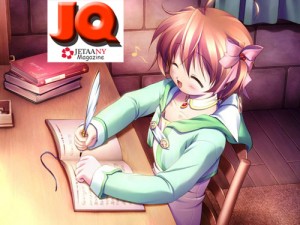


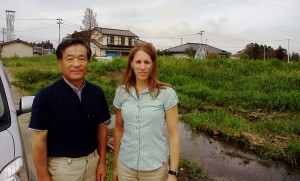
![ny_001[10]](http://jetwit.com/wordpress/wp-content/uploads/2012/02/ny_001101-300x150.jpg)
